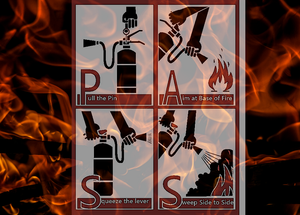MyWorldGo
Portable Fire Extinguishers Australia
Blog Information
- Posted By : ELI SHE
- Posted On : Mar 30, 2022
- Views : 305
- Category : General
- Description : Where to Locate Fire Extinguisher? Fire Extinguisher Australia Standard Compliance with Australian Standard AS2444 Types of fire extinguishers
Overview
- Where to locate fire extinguisher?Portable fire extinguishers is governed by the Australian standard AS2444. There are no simple rules to follow because each building is different, both in its layout, and fire risks. There are some general guidelines for locating fire extinguishers on the wall, and for the traveling distance to get to a fire extinguisher. Some of the fire extinguishers location requirements include:Fire Extinguisher Australia Standard:
-
Compliance with Australian Standard AS2444 – adjust the rules to conform to the building layout and the fire risks that are determined
-
Types of fire extinguishers – there are several classes of fire extinguishers that are designed to be used for specific types of fires.
-
Determine the type of fire risk first before purchasing the extinguisher for that area. For example there is a specific class of fire extinguisher for grease or cooking fires which should be located near a kitchen area
-
Types of mounts to use – there are fire extinguisher cabinets available that would be appropriate for locations that are susceptible to damage from people traffic. Bracket mounts are also used in areas where there is not quite as much traffic. Others may simply stand the extinguisher in a corner area where it cannot be easily knocked over. All are adequate solutions so long as the location and height are in compliance
-
Location and height – the fire extinguishers location requirements according to AS2444 instruct that the installation should be at least 10 centimetres off of the floor, and the top of the extinguisher should be no more than 1.2m above the floor. This keeps the extinguisher relatively safe from bumping with cleaning equipment or other items while also keeping the device easily reachable
-
Distance from risk area – depending on the type of fire risk, the distance can range from 15m to 40m. For example Class A fire risks, which are the most common, would recommend 15m maximum distance according to the Australian Standards
-
Signage – the signs that direct people to the location of a fire extinguisher must be easily visible down a typical corridor. The sign should be directly above the device, and specify the type of fires the extinguisher is used for and an arrow pointing to the extinguisher. The signs and the extinguishers themselves should have colour coding that will help people make fast decisions during an emergency. For example a Foam fire extinguisher – AFFF (Aqueous Film Forming Foam) fire extinguishers are painted red with a blue label are used on Class B fires (liquids such as petrol, paints, oils etc). A wet chemical extinguisher, used for fires from fats or cooking oils, would have a yellow coloured label. The size of the sign is determined by considering it must be readable from up to 20 metres away.
-
Installation – the location for installing a fire extinguisher should be determined by a trained professional that can assess the fire risks and then recommend the location for install. Various criteria are considered in determining the location such as easy access, not too close to the fire risk, location of nearest exit, visual limitations or obstacles, and other criteria. Because so many factors are to be considered, using an experienced provider is highly recommended.
4L Fire Extinguisher for Lithium Ion BatteryBuy NowKnowing how to operate a fire extinguisher could save your life in an emergency. The key to putting out a fire with an extinguisher is to use the PASS strategy:Pull the pinAim the hoseSqueeze the leverSweep the hose.
 However, before you use a fire extinguisher to put out a fire, it’s very important that you determine whether or not it’s appropriate for you to be fighting the fire, and whether or not you’ll be able to put it out. If you don’t think you can fight the fire, or if you have any doubts, evacuate the building immediately and call the fire department. Fires double in size every 60 seconds, so you don’t want to be fumbling around in an emergency situation, reading over the instruction manual as a small flame on the stove grows into an inferno.
However, before you use a fire extinguisher to put out a fire, it’s very important that you determine whether or not it’s appropriate for you to be fighting the fire, and whether or not you’ll be able to put it out. If you don’t think you can fight the fire, or if you have any doubts, evacuate the building immediately and call the fire department. Fires double in size every 60 seconds, so you don’t want to be fumbling around in an emergency situation, reading over the instruction manual as a small flame on the stove grows into an inferno. -
